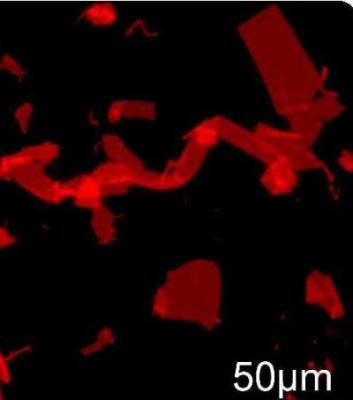A research team from the US Department of Energy’s Lawrence Berkeley National Laboratory (LBL) have developed a method through which two-dimensional nanosheets can be created for use in applications involving filtration, sensing and growth of nanostructures.
 This is a fluorescence microscope image of nanosheets (some overlapped and folded) formed by manually shaking a vial, labeled with Nile Red dye and depositing solution on an agarose substrate. Credit: Molecular Foundry, Berkeley Lab
This is a fluorescence microscope image of nanosheets (some overlapped and folded) formed by manually shaking a vial, labeled with Nile Red dye and depositing solution on an agarose substrate. Credit: Molecular Foundry, Berkeley Lab
As part of the study, the team headed by Ron Zuckerman, Director of Biological Nanostructures Facility at the Molecular Foundry, used a Langmuir Blodgett trough. This trough is a bath of water which has paddles coated with Teflon at each end. This helps in studying the way in which peptoid nanosheets gather at the surface of the water also known as air-water interface. The team had earlier found out this phenomenon about peptide molecules ability to assemble themselves in the form of ropes and sheets. Upon application of pressure these peptoid molecules that get collected on the water surface are drawn in the form of peptoid nanosheets.
Through this understanding of the mechanism of the assembly of peptide nanosheets helped the team with the design rules for creating large-scale nanomaterials. The team developed a device called the sheet rocker which rocks the peptoid vials through a careful vertical to horizontal motion allowing the compression of molecules to form nanosheets on the air-water interface. This shaking motion enabled the petoids to squeeze to form nanosheets within the air-water interface that acts like a catalyst in recovering 95% of the particles into nanosheets. These nanosheets are applied in platforms to detect molecules or act as membrane filters.